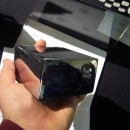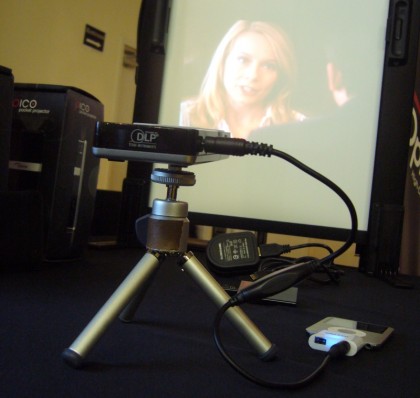I ran across two very interesting and diminutive products at CES Unveiled earlier this week. While the technology is compelling, I suspect the implementation will have to improve and the challenge these products solve will have to be clarified before we’d see any sort of mainstream or mass market adoption. Generating positive attention and finding commercial success are two entirely different matters.
Micro “personal” projectors seem all the rage these days. No doubt about it, it’s the kind of tech that makes geeks giddy. In fact, the Optoma Pico Projector table was mobbed. Their tiny projector beams video content from any composite source or video-capable iPod device… to the back of a tray table on an airplane? As cool as the Pico is, I’ve had a difficult time coming up with practical uses for the $400 low lumen (60), half VGA LED output. However, the Optoma rep did tell me they’re continuing to develop this technology – if they’re able to bump the resolution and brightness (and thus effective projected image size), the Pico could find an audience amongst business folks who travel light. But in it’s current form, I’d rather share my laptop screen with you.
 For nearly a decade I’ve heard the promise of Windows-based “thin client” computing, but have yet to see many widespread deployments. And perhaps that’s why Pano has chosen to market their sexy, shiny box as a “desktop virtualization” solution – although “cloud computing” is the current trendy positioning. Even if this cloud would be local and low-hanging. (Fog computing?) While Pano’s technology may be solid, and in the literal sense the hardware surely is, Microsoft’s licensing terms are ambiguous and large corporate entities (where the money is) are unlikely to entrust their productivity to a newcomer.
For nearly a decade I’ve heard the promise of Windows-based “thin client” computing, but have yet to see many widespread deployments. And perhaps that’s why Pano has chosen to market their sexy, shiny box as a “desktop virtualization” solution – although “cloud computing” is the current trendy positioning. Even if this cloud would be local and low-hanging. (Fog computing?) While Pano’s technology may be solid, and in the literal sense the hardware surely is, Microsoft’s licensing terms are ambiguous and large corporate entities (where the money is) are unlikely to entrust their productivity to a newcomer.
Having said all that, I do see promise in both these technologies and will continue to observe the product categories as they evolve.
